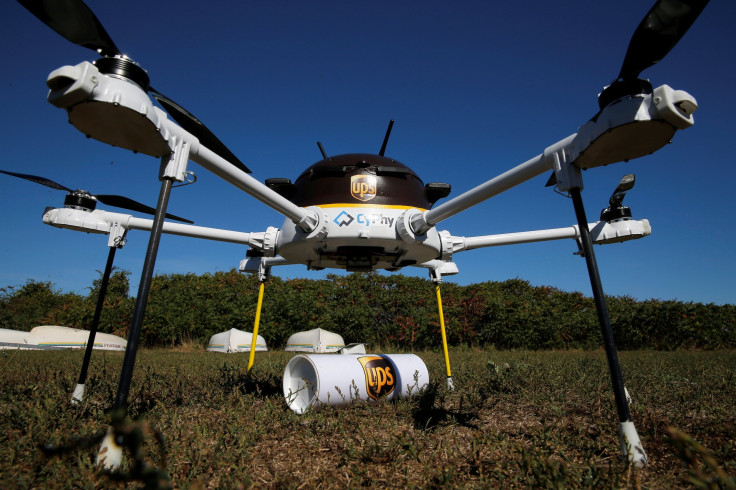Drone Deliveries Could Change Logistics Permanently

Drones are slowly but steadily becoming mainstream with its increasing use by the military and enthusiasts alike. However, the commercial usage of drones for business-to-customer operations is what will actually make them common.
One such usage of drones is for making deliveries. Unmanned aerial vehicles might be a great alternative to the current system of making deliveries. Big tech companies such as Google, retail giants such as Amazon and even specialized delivery services such as UPS are betting on drone deliveries as the alternative to the current system of human-based deliveries, which comes at high-costs, doesn’t have a high rate of making timely deliveries and even increases base costs due to pilferage.
Read: Autonomous Drone-Flying Car Hybrid Being Developed At MIT
Drone-based delivery is increasingly being tested for widespread implementation. It faces challenges on using the airspace for commercial drones, keeping such drones safe, the cost and even the environmental implementation of such as paradigm.
Yet, the probability that we may see drone delivery becoming mainstream in the near future, maybe even by the end of the year is high. And why are companies investing in it? The answer lies in the economics of drone delivery.
According to Flexport, drone-based deliveries will cut down both wait times and the cost of human labor significantly. Last mile delivery depends on two factors — route density and drop size. Route density refers to the number of drops being made on a single delivery route, while drop size refers to the number of parcels delivered at each drop.
Drone-based deliveries, since it is not plagued by human factors such as fatigue, can be done more number of times over a short period of time, which will make the cost of making such deliveries low. If a big drop can be made, the cost per parcel will also be low.
Faster deliveries are another aspect that needs to be taken into consideration, and it might be what prompted Amazon’s interest in the technology. After all, the retailer was the first of its kind to shorten the traditional seven-day delivery service by offering two-day deliveries to customers. Delivering packages in 30-minutes or less would mean better customer service and more orders being delivered over time.
According to ARK Invest researcher Tasha Keeney, Amazon’s Prime Air drone-based delivery would cost 88 cents per delivery for delivering a 5 pound package within 10 miles. If Amazon charged its customers just $1 per delivery, it would have a 50 percent return on investment on its drone infrastructure. It will still be cheaper than the current $5.99 cost of doing so, and the drone drops would be same-day deliveries as compared to current next-day deliveries.
Another important and maybe even worrisome aspect of drone-based deliveries is the utilization of airspace, most importantly, avoiding airplanes. Amazon has proposed limiting the height that drones should be allowed to fly to 400 feet.
But, it might still have potential to hit low-flying planes or of drones crashing into each other. A better solution might be creating airplane style, pre-approved flight plans. If the routes of drones are planned and approved, including metrics such as height and distance, this might make regulating drones easy and could determine proper airspace usage.
This might go in line with Amazon’s recent patent, which proposes creating airport-like control centers in each city, which will let drones take off and land to make deliveries.
In addition to this, NASA is developing a system that would make it easier for drones to land in highly populated areas, should anything go wrong.
But what about the environmental impact of drone-based deliveries? The answer might surprise you — according to a study by the University of Washington, drone based deliveries may be more environment-friendly than truck deliveries.
“We were surprised to find that for some realistic conditions, drones produced less CO2 per delivery than trucks. They perform better with smaller distances, and fewer packages in the truck. This is largely due to their incredibly energy efficient and lightweight design,” Dr. Anne Goodchild, associate professor of civil and environmental engineering at the University of Washington, stated in a research paper titled “ Delivery by drone: An evaluation of unmanned aerial vehicle technology in reducing CO 2 emissions in the delivery service industry” published in March.
Drone-based deliveries might hold many more benefits than just convenience, one of them being the ability to reach tough terrains and deliver medicines on time. Not only that, given the state of American infrastructure, they might be an alternative until better roads are built.
According to the American Road and Transport Association, making a new road in such areas might cost around $5 million per mile, while a drone network will cost less than $1 million. Building and maintaining roads is a long and costly process. A drone network might be able to offer last mile connectivity in a much cheaper, faster and more usable way.
© Copyright IBTimes 2024. All rights reserved.





















